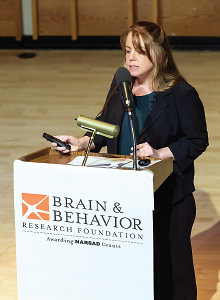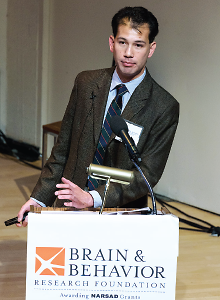For almost 30 years, the Brain and Behavior Research Foundation (BBRF) has aimed to support early career researchers in neuroscience and psychiatry through the NARSAD Young Investigator Grants—two-year awards of up to $70,000. This year, BBRF awarded 198 Young Investigator Grants totaling nearly $14 million.
During BBRF’s annual research symposium in October, NARSAD Young Investigator recipients Tracy Butler, M.D., a research assistant professor of neurology and psychiatry at New York University, and Timothy Mariano, M.D., Ph.D., an instructor at Harvard Medical School and associate psychiatrist at Brigham and Women’s Hospital, spoke of how receiving Young Investigator Grants in 2015 has helped them pursue innovative ideas for addressing emerging areas of mental health concern.
During her talk, Butler described her interest in determining whether some of the many military personal diagnosed with posttraumatic stress disorder (PTSD) might have chronic traumatic encephalopathy (CTE). PTSD and CTE share many clinical features, yet determining which one someone is afflicted with is nearly impossible as currently CTE can be diagnosed only by autopsy.
A newly developed imaging tracer that can visualize the brain protein tau—which accumulates in neurodegenerative conditions such as CTE and Alzheimer’s—might provide a way to reliably diagnose CTE in living people, Butler said.
Butler said she plans to use such a tracer to evaluate veterans who have a history of traumatic brain injury and have been diagnosed with PTSD and/or depression to test whether distinct patterns of tau accumulation and distribution can separate people with CTE from those with a psychiatric illness and/or those with early Alzheimer’s. Butler is also working with a colleague at NYU to measure blood levels of tau in these participants (using a new ultrasensitive blood protein detector). If blood levels correlate with brain levels of this protein, it may reduce the need for expensive imaging, she said.
Butler said she believes that differentiating PTSD from CTE can lead to improved interventions, as these two conditions have a much different neurological basis.
Another challenging disorder to manage is chronic pain. As Mariano explained during his lecture, therapies today are much better at treating nociception (the physical sensation of pain) than treating the emotional side of pain, often referred to as suffering.
For his Young Investigator project, Mariano is examining whether neuromodulation can improve the emotional symptoms of pain. He noted that transcutaneous electrical nerve stimulation devices are already widely used to treat sensory pain, so it’s possible the same strategy will work when applied to the brain.
Although transcranial direct current stimulation (tDCS) is still experimental and may have some risks, he said it could prove a valuable therapeutic strategy, particularly for people who are at risk of opioid use disorder.
In a recently completed pilot study in healthy subjects, Mariano found that people who received low-dose tDCS were better able to tolerate pain than those who did not receive the intervention. He is currently conducting a small randomized, controlled study of tDCS in patients with chronic back pain.
Alan Schatzberg, M.D., a professor of psychiatry at Stanford University who commented on the young investigator lectures, told Mariano and Butler that they might find themselves back on the same stage in a future BBRF symposium; many of the scientists honored with outstanding achievement awards got their start with the help of a BBRF grant as well. ■
More information on the NARSAD Young Investigator Grants can be accessed
here.


